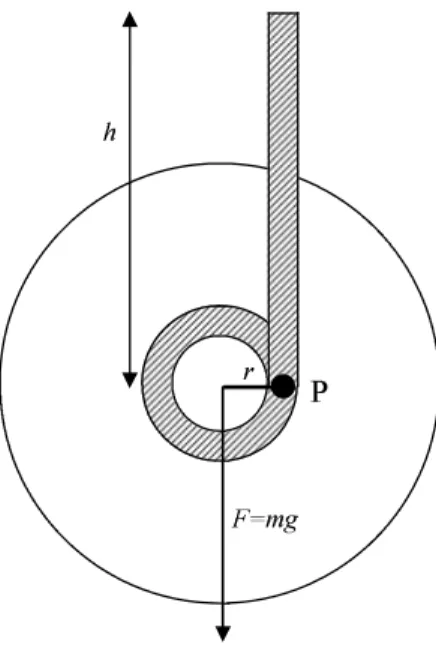IM3
Modul Mechanics
Maxwell’s Wheel
In the present experiment, the conservation of energy based on Maxwell’s wheel is examined. The Maxwell’s wheel is a metal wheel with large mo- ment of inertia, with both sides of its axis suspended by a thread, on which it can roll. During the experiment, the potential energy is trans- formed into kinetic energy linearly by rotational motion.
Versuch IM3 - Maxwell’s Wheel
In the present experiment, the conservation of energy based on Maxwell’s wheel is examined.
The Maxwell’s wheel is a metal wheel with large moment of inertia, with both sides of its axis suspended by a thread, on which it can roll. During the experiment, the potential energy is transformed into kinetic energy linearly by rotational motion.
c
AP, Departement Physik, Universität Basel, March 2021
1.1 Preliminary Questions
• What is the definition of the moment of inertia of a rigid body?
• Calculate the moment of inertia of a sphere, a cube, and a cylinder.
• How does the moment of inertia change with a shift/rotation of the axis?
• What force acts on the suspension of the Maxwell wheel in each movement phase (rest- ing, rolling, turning point, rolling up)?
• What are the forces that act on the turning point?
1.2 Theory
1.2.1 Ideal Maxwell’s Wheel
Maxwell’s wheel is suspended on a string. When the wheel falls, it falls slower than a wheel of the same mass in free fall. The potential energy is converted into, not only translational motion, but also rotational. Around the height of the fall as a function of the time, there are two approaches:
1. Ansatz via the conservation of potential, kinetic translation- and kinetic translational rotational energy:
d
dt Epot+Ekin,trans+Ekin,rot
=0 (1.1)
2. Ansatz via the torque. In Figure 1.1, Maxwell’s wheel is shown. It has a massmand a moment of inertia Θ. From Newtonian mechanics, one can find solution for rotational motion and torque, which acts on the string.
Figure 1.1: Maxwell’s Wheel
3
In both cases, one needs a constraint, the speed and angular velocity are connected with each other. We follow the first Ansatz here and first write the energies in (1.1):
d dt
mgh(t) +1
2mv2(t) +1
2Θω2(t)
=0 (1.2)
The center of the suspension axis moves with velocityvdown. To roll, points that are located on the radius of the axis must move with opposite, but equally large, in amount of speed. In other words, it applies:
v=ωR Used in (1.2) gives:
d dt
mgh(t) +1
2mv2(t) +1 2Θv
R 2
(t)
=0 (1.3)
Now we carry out the derivation and usev=h. The solution should look like this:˙ h(t) = 1
2
mgR2 mR2+Θt
2 (1.4)
Here, the moment of inertiaΘused is not the "symmetrical" inertiaΘS. The wheel does not roll around an axis, but it goes through the geometric center, and about an axis, which passes through the point P, at which the string leaves the straight axis. However, with Steiner’s theorem one can calculateΘS:
Θ=ΘS+mr2 (1.5)
1.3 Experiment
1.3.1 Equipment
Component Number
Maxwell’s Wheel 1 Scale with Pointers 1
Base 1
Socket block 1
Foot stand 2
Support rod 50cm 2 Support rod 100cm 2
Sleeve 4
1.3.2 Experiment setup and Execution
• To measure the light barrier, a stopwatch is not necessary.
• Position the height scale at an appropriate location.
• To measure the rolling time, choose tE→Ffrom the counter and operate with the magnetic switch of Maxwell’s wheel.
4
• Initialize the measurement by pressing theSTARTbutton. Once the wheel is free from the counter, start the time measurement until it passes through the light barrier and is stopped.
• Note the time and set the measurement by pressing theRESETbutton.
• Choose the measurement of the velocity when passing through the light barrier of ap- proach tE on the counter and operated again with the magnetic switch of Maxwell’s wheel.
• Initialize the measurement again by pressing the START button. If the wheel is now detached from the counter, the time is measured∆t which is required to go through the light barrier.
• Note the time and set the measurement again by pressing theRESETbutton.
It is recommended that the read on the length scale value Write and afterwards to be provided with the scale value for the stationary Maxwell wheel expected. The determi- nation of the absolute position of the wheel on the scale length is tricky. Think about how big the problem is and try to minimize it.
1.3.3 Measurements
• Measure the time it takes for Maxwell’s wheel go to heighth. It must be measured for 10 different heights, each at least three times.
• Also measure for each height three times the time required for the wheel to go through the light barrier.
1.3.4 Tasks for Evaluation
• Determine the mean, standard deviation, and the standard deviation of the average value for all measured times.
• Calculate the instantaneous velocity at the height of the light barrier and perform the error calculation as well.
• In a diagram, show the distance traveled and the velocity as a function of time and perform a fit.
• Calculate the moment of inertia by means of energy conservation and carry an error calculation as well.
• In a diagram for the potential energy, the rotational energy, the translational energy, and the kinetic energy as a function of time, check if energy conservation is satisfied.
5
